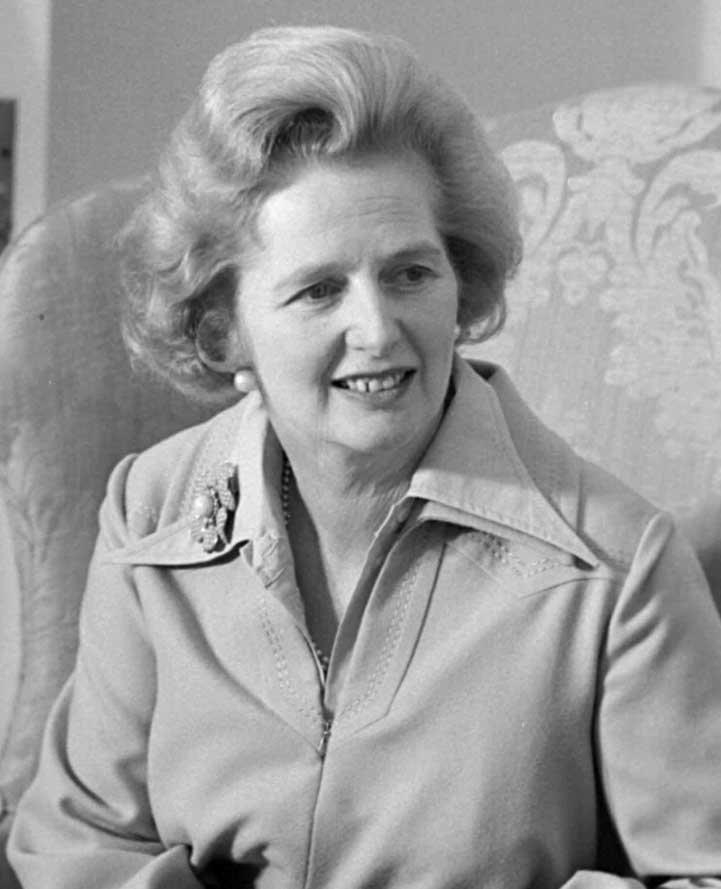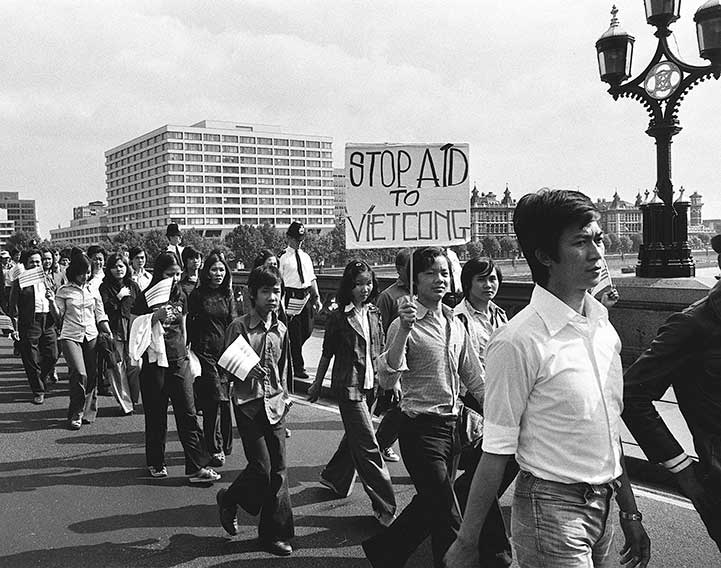
Select Language: tiếng Việt
Vietnamese refugees in Britain
The orphan airlift
In the years immediately following the end of the Vietnam War, there was a great public concern in the UK for the many thousands of refugees fleeing the country. As a consequence, in 1975, the UK Government agreed to increase its foreign aid programme to Vietnam (which had actually been running throughout the war) beyond the £1 million mark.
This money was to be only made available to organisations who were able to work in both the north and south of Vietnam (the two parts were not reunified until the following year), meaning that aid was generally distributed though large multinational aid organisations such as the Red Cross and Unicef.
Some efforts to help the children of Vietnam were slightly more controversial however. In April 1975 the Daily Mail editor David English, with the help of a Christian organization Project Vietnam Orphans (PVO), decided they would airlift 99 Vietnamese children from orphanages in Saigon. The airlift was incredibly chaotic: many of the children were unable to receive the constant medical attention their fragile conditions necessitated; and a large number of the children had no proof of their identity nor even that they were orphans.
Although all of the surviving ‘orphans’ were eventually allowed to stay in the UK (after a court case brought by the UK based charity, the Ockenden Venture), 3 children had died of malnourishment during the process of the ‘rescue’ and it was later reported in the New Statesman that many of the children were, as suspected at the time, not in fact orphans.
Although Britain had actually been accepting small numbers of refugees from South Vietnam since the mid-70s (900 in 1975 for example) in the British public conscious the term “Vietnamese refugee” is synonymous with the term “Boat People” and the relatively large number of refugees accepted from Vietnam in the last year of the decade.
After the victory of the North Vietnamese army and the reunification Vietnam, the internal policies of the communist government lead to a great number of Vietnamese fleeing their country in small, often rickety and overcrowded, fishing boats.
As a significant proportion of the “Boat People” (as they uniformly became known in the Western media) were ethnically Chinese, many of the boats set sail for the areas of Asia with well-established Chinese communities, such as Singapore and, particularly, Hong Kong.
The tens of thousands of refugees who arrived in the islands were put up in rudimentary refugee camps, but their sheer number was causing a significant problem for the Hong Kong authorities, and, by extension, the British government.
By 1979 the situation had come to a head: the boat people already in the camps on Hong Kong’s crowded islands numbered over 32,000, the conditions in many of the camps were terrible and, perhaps most importantly, they continued to arrive. Initially, the UK agreed to take 1,500 refugees who had been rescued at sea, followed by a further 1,400.
As the number of people living in the camps continued to rise, however, the Britain, as the nation responsible for administering Hong Kong, came under increasing pressure from the International Community to find a solution to the crisis in the camps.
Finally, in July 1979, at the conference in Geneva organized to discuss the refugee crisis, the British government agreed to take a further 10,000 Vietnamese refugees from the camps in Hong Kong.

Some Vietnamese refugees have hailed Thatcher as a champion of the Vietnamese people for this decision. However, recently released Downing Street papers reveal that Thatcher was reluctant to allow the ‘boat people’ into the UK, partly out of a fear that British people would react badly to so many council houses being granted to non-British nationals and partly due to a concern that the new immigrants, as Asians, would not integrate well. Thatcher said refugees from Poland, Zimbabwe and Hungary would be preferable as they stood a better chance of assimilating.
So keen was Thatcher to avoid an influx of Vietnamese refugees, that she floated the idea of jointly buying with Australia a Philippine island for the ‘boat people’. This idea was blocked by Lee Kuan Yew of Singapore due his concerns that it would turn into a rival entrepreneurial city.
Ultimately it was Thatcher’s colleagues, Lord Carrington (foreign secretary) and William Whitelaw (home secretary) who persuaded a reluctant Thatcher to accept 10,000 refugees. For his part, Whitelaw argued that “it is necessary that we should have a positive and defensible policy towards refugees from a brutal communist tyranny.”
Although Thatcher compromised over the acceptance of Vietnamese refugees, she maintained a tough stance with Vietnam on the issue of the continued exodus of ‘boat people’. In 1979 she announced that she would be stopping all British aid to Vietnam, the bulk of which would have been £4 million worth of food.
Thatcher believed that the only body that could prevent the number of refugees in the Hong Kong camps returning to their previous level was the Vietnamese government, which was widely believed to be pursuing policies aimed at forcing ‘undesirable’ elements out of the country.
The British government had initially attempted to negotiate directly with Hanoi to bring about an end to these policies, and when this showed no sign of progress tried to persuade the Soviet government to use its considerable influence to the same effect. Once this tactic failed to bear fruit, the Prime Minister made her announcement, complete with a strong denouncement of the role played in the refugee crisis by both the Vietnamese and Soviet governments.
Given that many of the millions of internal refugees in Vietnam depended on foreign aid for all of their basic needs, this decision was a particularly controversial one; even more so considering Thatcher’s refusal, on purely economic grounds, to halt the construction of three merchant vessels for the Vietnamese Government then being built in British ship yards. Matters were made worse for Vietnamese people when the EEC, influenced by Thatcher’s stand, halted the shipment of 100,000 tons of food to Vietnam, which included 15,000 tons of skimmed milk for young children.
Having accepted the refugees, the British government now had to find homes for them, and, in line with the ideology of the contemporary Conservative government, this was to be done with the smallest amount of central government intervention possible.
The majority of the huge responsibility for re-housing and re-settling the refugees therefore fell on the shoulders of a small number of voluntary organisations; a fact which later would lead directly to many of the volunteers involved suffering from “compassion fatigue’’: a condition perhaps more accurately described as physical and emotional exhaustion.
While the leg work of the resettlement was provided almost exclusively by volunteers, the direction of the project was still determined by the Home Office. The decision to take 10,000 refugees from a Southeast Asian country had been a controversial one, and so the Home Office drew up a number of guidelines for the resettlement programme with the aim of reducing any potential electoral backlash, particularly a galvanizing of the then growing National Front support.
For these reasons, the government decided that no one council should receive large numbers of refugees (the recommended number was 4 to 10 households), and that all incoming refugees were to be housed in camps for up to 3 months, where they would be taught the skills necessary to make them ‘job-ready’. This, the government hoped, would ultimately reduce the likelihood of the refugees requiring later state assistance through the benefit system.
The reality of the resettlement proved to be a lot more complicated than the clean simplicity laid out in the Home Office’s plan. As the government had delegated responsibility for finding the required housing to Local Government, it had no power to enforce the planned for dispersal of refugees; families were simply put where there were council houses for them and, ironically given the initial intention of the plan, this was predominantly in the larger cities, already home to large numbers of commonwealth immigrants.
In fact, this probably made little difference to the eventual distribution of the Vietnamese community throughout the UK, as the vast majority of those refugees who were initially settled in the intended small family groupings ended up moving to the large cities anyway; today 60% of the UK’s Vietnamese community live in London.
The ‘Welcome Camps’ did not come any closer to meeting the aims of the authorities. Although it is justifiably argued that the camps had an impossible task (particularly given the meagre resources at their disposal) it is generally accepted that they did not achieve their stated aim: 7% of the refugees were still living in the camps one year after their arrival and the nascent Vietnamese community suffered far higher unemployment rates than the national average. Indeed, only 16% of working age adults found work in the 1980s, with those who were employed working mainly as semi or unskilled labour.
Those arriving in the UK faced many challenges including the absence of a pre-existing community. Many were from North Vietnam and had had very little contact with western culture. Additionally, the significant numbers of the North Vietnamese refugees had come from poor, rural areas and were poorly educated even in their own language.
As a result they had no experience of a modern industrial economy and did not possess skills that were transferable or immediately marketable in the UK. Furthermore, the Vietnamese refugees were internally divided by race, religion and geographic origin and they arrived in Britain at a time of recession and high unemployment.

Vietnamese boat people marching to present a petition to the Prime Minister at 10 Dowing Street calling on the government to seek the expulsion of Vietnam from the UN for breach of the UN Declaration of Human Rights. It also asked Britain to sever relations with the Hanoi government. (AP Photo)
Of all the Vietnamese refugees arriving in the UK, those who struggled the most were those who had stayed in Hong Kong’s notoriously violent camps for long periods. These people, some of whom had been in the camps for over three years, faced serious disadvantages including drug addiction and an unemployment rate of 92%.
After the arrival of the initial 10,000 refugees, many of their family members moved to the UK in order to be reunited with their loved ones. Taking into account this further group of arrivals, the final number of refugees from Vietnam who arrived in the UK between 1975 and 1988 was 22,577. This figure continued to climb over the following years until it reached a reported 30,000.
Some first-generation Vietnamese refugees have enjoyed economic success in Britain, opening up thriving restaurants, shops and other small businesses. Over the last 30 years, Vietnamese restaurants and nail salons have become ubiquitous in London, occupying premises in areas ranging from the impoverished Peckham Rye neighbourhood to the superbly wealthy district of Chelsea. Mare Street and Kingsland Road in Hackney, East London, are well known for their high concentrations of Vietnamese businesses, especially restaurants.
But many of the original Vietnamese refugees have continued to struggle to integrate and find employment in their new homeland. Many have lived on welfare payments and depended on Vietnamese community centres, such as the Lambeth Elderly Association from Vietnam, to translate letters and bills and provide community and exercise sessions.
Yet despite the multiple challenges faced by Vietnamese refugee families both before and after their arrival in Britain, they have by and large remained unified and continued the Chinese and Vietnamese tradition of fostering strongly interdependent relationships between family members, especially between parents and children.
Many refugee parents, whose lives have been dominated by the struggle to survive, have rested their hopes and dreams for the future on the shoulders of their children. And for so many first-generation Vietnamese people, their real victory has been the outstanding success of their sons and daughters. At the Lambeth Elderly Association from Vietnam, for example, it is not unusual to find long-term unemployed and non English-speaking elderly Vietnamese parents whose children have graduated from elite British universities and gone on to become extremely wealthy.
New movements of Vietnamese people to Britain
The days of granting automatic refugee status to any Vietnamese people who have managed to leave their country are long gone. Given that the panic (both internal and international) that followed the Communist victory in 1975 has long since subsided and that the country has witnessed increased social freedoms and prolonged peace, Vietnam has come to be regarded as a relatively safe country to live in.
Consequently, asylum claims made by Vietnamese nationals are now regarded as relatively weak, especially when compared to those made by people fleeing the world’s more recent trouble spots such as Syria, South Sudan, Iraq, Afghanistan, Somalia and Rwanda.
The exceptions to this rule are the cases of members of Vietnam’s Khmer and ‘Montagnard’ ethnic minority groups, both of whom have endured cultural, religious and economic persecution at the hands of the Vietnamese Government. In recent years, the Communist authorities have launched ferocious crackdowns on these minority groups, causing some to flee into Cambodia or Thailand. There are no indications that any of the asylum seekers from the Khmer or ‘Montagnard’ ethnic groups are being re-located in Britain.
Those Vietnamese nationals making their way to Britain today are either ethnic Vietnamese (called ‘Kinh’ in Vietnamese) or ethnic Chinese-Vietnamese people entering the country as students of prestigious UK universities or as asylum seekers. The profile of these migrants mirrors Vietnam’s increasing levels of economic inequality: the students hail from Vietnam’s new super-rich elite while the asylum seekers come from impoverished backgrounds.
The most unfortunate of the Vietnamese people arriving in the UK now are those who have been trafficked here and face long periods of unpaid labour to pay off huge debts to those who organized their journeys. Children as well as adults arrive in the UK this way and a recent trend has seen Vietnamese boys trafficked to work as near-slaves in cannabis factories in British homes. In 2012, 96 Vietnamese children were referred to the government's main trafficking agency, making it the highest ranked country of origin for suspected victims of trafficking under the age of 18.
